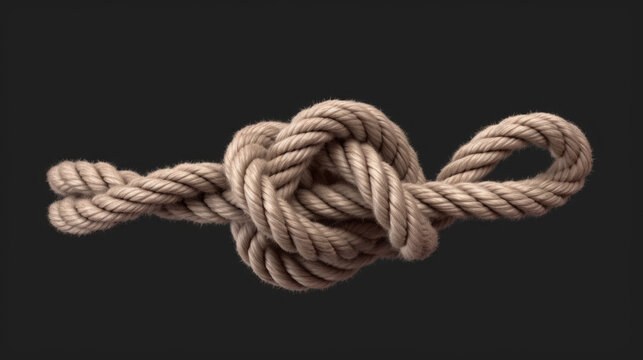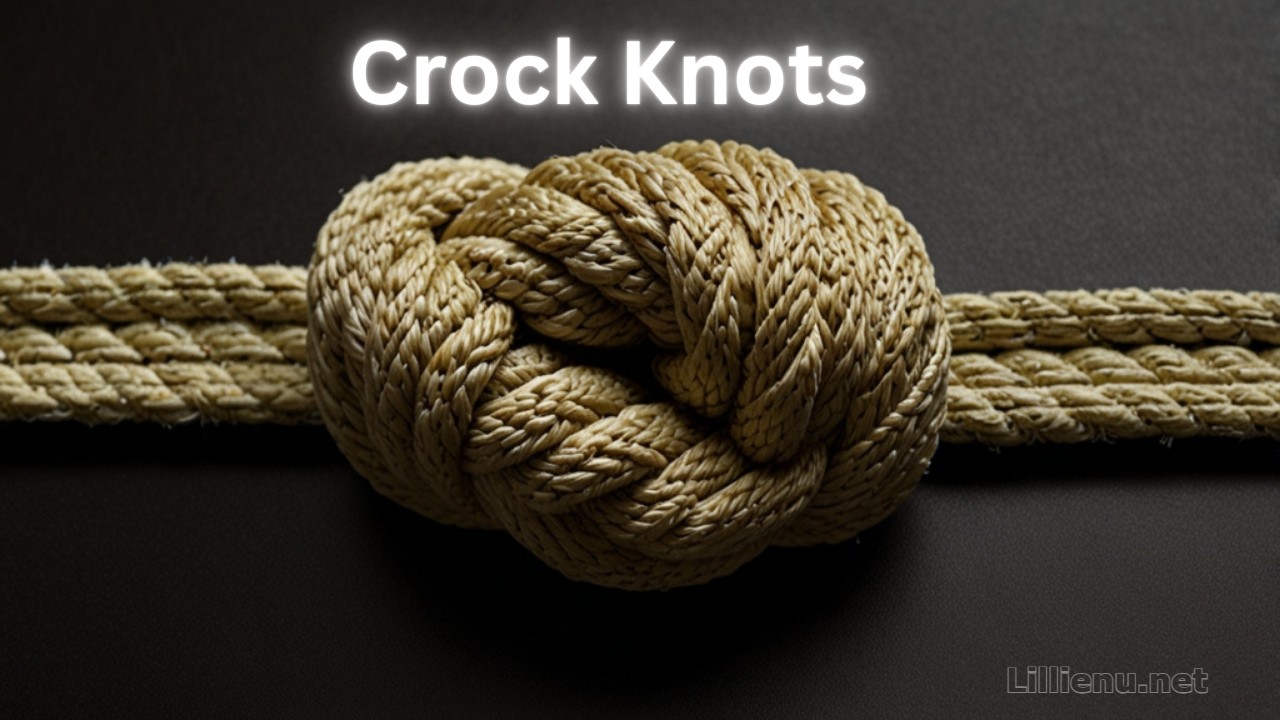The Crock Knot is a powerful knot, often regarded as one of the most reliable and simple options for securing hooks, lures, or other tackle fishing lines. It is known for its strength and simplicity, making it a go-to knot for anglers, campers, and outdoor adventurers alike.
Whether you’re preparing for a fishing trip, setting up camping gear, or performing any outdoor task that requires reliable knotting, the Crock Knot is an essential knot you should master.
What is the Crock Knot?
The Crock Knot is a type of knot primarily used for attaching hooks, lures, or other tackles to a fishing line. It is also popular in outdoor activities like camping and climbing, where securing items safely is necessary.
The knot is relatively easy to tie, which is why it has gained popularity among both novice and experienced anglers. When tied correctly, the Crock Knot offers significant strength, ensuring that your fishing tackle will not fail when you need it the most.
Its versatility and reliability in both freshwater and saltwater environments make it an ideal knot choice for fishing. The Crock Knot’s simplicity means you can quickly tie it even in difficult conditions, such as when fishing in windy weather or at night.
Why is the Crock Knot So Effective?
The Crock Knot is effective because of its ability to create a stronghold with minimal effort. It utilizes a series of wraps that create a secure grip on the line, helping it hold up even under tension. This is essential for fishing where you’re dealing with the unpredictable movement of fish, often pulling hard against the line.
The strength of the Crock Knot comes from the way it distributes pressure evenly across the line. This makes it highly resistant to slippage, ensuring your hook, lure, or other gear remains firmly attached. Its simplicity means there are fewer chances of error during the tying process, making it an ideal choice for anyone looking for a reliable and easy-to-tie knot.
How to Tie a Crock Knot: A Step-by-Step Guide
One of the main advantages of the Crock Knot is how easy it is to tie. With just a few simple steps, you can secure your tackle and prepare your gear for outdoor activities. Follow this guide to master the Crock Knot:
- Insert the Line Begin by passing the fishing line through the eye of the hook or other tackle you plan to use. Ensure that enough line is left for the tying process, typically a few inches.
- Form a Loop Create a small loop with the tag end of the line, and hold it in place with your thumb and forefinger. This loop will be used to form the wrapping part of the knot.
- Wrap the Tag End Wrap the tag end of the line around the standing part of the line at least three to five times. The more wraps you make, the stronger the knot will be. Ensure each wrap is snug against the previous one, creating a compact coil.
- Thread Through the Loop Pass the tag end of the line through the loop you formed in Step 2. This is the critical part of the knot as it secures the coils in place.
- Tighten the Knot Slowly pull both the standing line and the tag end of the line in opposite directions. Tighten the knot gently, making sure the wraps stay intact and the knot is even.
- Trim the Excess Line After the knot is secure, trim any excess tag end of the line. This ensures that the knot won’t get caught on any other objects, preventing any interference with your outdoor activity.
Best Applications for the Crock Knot
The Crock Knot is incredibly versatile and is widely used across various outdoor activities. Here are some of the best applications where the Crock Knot shines:
- Fishing: The Crock Knot is widely used by anglers to securely tie hooks, lures, and other tackles to their fishing line. It’s particularly valuable when targeting large fish that exert a significant amount of force on the line. By using the Crock Knot, you can confidently fish knowing your tackle is securely attached.
- Camping: The Crock Knot can also be used for camping tasks such as securing guy lines to tents or tarps. It is perfect for preventing tents from shifting in windy conditions or ensuring that your shelter stays stable during a storm.
- Climbing and Hiking: When you need to secure climbing ropes, backpacks, or other gear, the Crock Knot is up to the task. Its strength and reliability make it a useful tool in outdoor adventures where gear security is crucial.
- Boating and Water Sports: Due to its reliable strength, the Crock Knot is used for securing lines on boats, kayaks, and canoes. It ensures that ropes remain firmly attached, even when subjected to wet conditions or heavy pulls.
Why the Crock Knot is Ideal for Outdoor Enthusiasts

If you’re an avid fisherman, camper, or adventurer, the Crock Knot offers a level of convenience and security that makes it an essential knot to know. Here are some reasons why outdoor enthusiasts swear by the Crock Knot:
- Quick and Easy to Tie
One of the biggest advantages of the Crock Knot is its simplicity. Even beginners can tie it with ease, and experienced anglers and campers can do it quickly without wasting time. - Strong and Secure
The Crock Knot is known for its excellent strength, ensuring that your gear won’t come loose, even in stressful conditions. Its tight, reliable wraps are perfect for securing hooks or ropes under heavy loads. - Versatility
The Crock Knot can be used for a wide range of outdoor activities, from fishing to hiking, climbing, and camping. This versatility makes it one of the most useful knots for outdoor enthusiasts. - Low Maintenance
Unlike other knots that may require constant adjustment or retightening, the Crock Knot, once tied properly, stays intact. Its stronghold eliminates the need for frequent checks or maintenance.
Tips for Tying a Strong Crock Knot
To ensure you get the most out of the Crock Knot, here are some essential tips to follow:
- Moisten the Line: Before pulling the knot tight, always moisten the fishing line with water or saliva. This will help the line slide more easily and reduce friction, preventing damage to the line and ensuring a smooth tightening process.
- Ensure Tight, Even Wrapping: As you wrap the line around itself, make sure each loop is tight and evenly spaced. Uneven wraps can cause the knot to weaken, resulting in slippage.
- Test the Knot: Once the knot is tied, test its strength by gently pulling the line. If the knot slips or feels loose, retie it. A properly tied Crock Knot should not budge under tension.
Common Mistakes to Avoid
While tying the Crock Knot is easy, beginners sometimes make a few mistakes that can compromise the knot’s strength. Here are some common mistakes to watch out for:
- Not Making Enough Wraps: One of the most common errors is not wrapping the line enough times. Insufficient wraps may lead to a weak knot that won’t hold under pressure.
- Not Pulling Tight Enough: If you don’t pull the line tight enough, the knot may loosen. Always ensure the knot is fully tightened before cutting off any excess tag end.
- Skipping the Moistening Step: Failing to moisten the line before tightening can cause friction that weakens the knot. This step is essential for a secure, durable knot.
Crock Knot vs. Other Knots: A Comparison
There are several knots commonly used in fishing and outdoor activities. Let’s compare the Crock Knot with other popular choices:
- Crock Knot vs. Clinch Knot: The clinch knot is similar to the Crock Knot but tends to be slightly more difficult to tie. While the clinch knot can be strong, it’s more prone to slippage, especially when not tied correctly. The Crock Knot provides more security in these cases.
- Crock Knot vs. Palomar Knot: The Palomar knot is another strong option, but it’s bulkier and requires more effort to tie. The Crock Knot, on the other hand, is simpler and more effective for most everyday tasks, making it ideal for those looking for a quick and strong solution.
Conclusion
In conclusion, the Crock Knot is an indispensable tool for anyone who enjoys outdoor activities such as fishing, camping, and hiking. Its simplicity, strength, and versatility make it the perfect knot for securing tackle, ropes, and gear.
By mastering the Crock Knot, you ensure that your equipment stays safe and secure throughout your outdoor adventures, allowing you to focus on enjoying the experience. Whether you’re a beginner or a seasoned outdoor enthusiast, the Crock Knot is a knot you can rely on time and time again.
